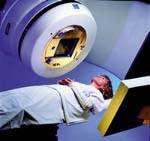Early detection of breast cancer leaving
The mammary gland is one of the natural beauty and 'pride' of women. Not only that, but the mammary gland also helps women complete their motherhood after giving birth. However, the risk of breast cancer is always pursuing and haunting women.

Breast cancer patients are being treated with radiation (radiation therapy)
In countries, the proportion of women with breast cancer increases steadily every year, worldwide, and female breast cancer is ranked as the top risk category. According to the World Health Organization (WHO), it is estimated that in 2005 there were about 1,200 thousand people suffering from breast cancer and according to the American Association of Cancer Prevention, there will be about 270 thousand new cases, equivalent to 1/10 female population infected in 2005.
In Vietnam, research on cancer in recent years has shown that breast cancer in women is the most prevalent cancer in Hanoi and northern provinces; the second highest risk (after cervical cancer) in Ho Chi Minh City and southern provinces. The number of new cases of breast cancer is about 800/2 million cases in Hanoi and about 600/3 million visits in Ho Chi Minh City and most patients are over 40 years old.
Due to lack of knowledge, most patients go to hospital when the disease is in stage 3 and 4 (late stage). Therefore, all cases of this breast cancer must be treated with the emulsion method (removal of the entire mammary gland). This greatly affects the physiology of the patient.
Dr. Vo Kim Dien, Head of FV Hospital's Oncology Department, said breast cancer can be completely cured if detected at an early stage. The earlier the stage, the higher the ability to cure, especially still able to preserve the mammary gland.
According to European-American statistics, about 90% of patients are in stage 0 and phase I can cure completely.
' In the world, the mammary gland conservation method has been put into research since the 70s and officially put into treatment in the 90s. Conservation surgery helps to keep the aesthetics for mammary gland, recovery time after rapid surgery and the patient is not required to have breast reconstruction surgery later. The rate of cure, survival time, recurrence rate and metastasis of conservative surgery compared to the emulsion is now considered the same but the cost of treatment is only equivalent or lower '- Doctor Dien said .
However, this conservative treatment is only applicable when the patient detects cancer at an early stage, when the tumor is less than 3cm and has no distant, non-invasive metastases. The current conservation method is to remove the tumor, to remove the axillary along the side and radiotherapy to the mammary gland + lymph nodes. For cases of tumors greater than 3cm, if the patient wishes to keep the mammary gland, it can still be preserved but this depends on the patient's medical condition.
According to the experience after 25 years of conservative treatment of breast cancer by Dr. Tran Ngoc Quang, Head of Oncology and Radiation Department of Saint-Quentin Hospital (France) and a professional advisor for FV Hospital's Oncology Department. If breast cancer is found to be less than 2cm, the likelihood of success of high conservative and conservative treatment is very good. Results of mammary gland treatment in this case are equal to or better than emulsions.
The retention of breasts under current conservative treatment makes it easier for women to accept treatment, no longer worried and obsessed with the removal of the entire mammary gland according to ancient treatment Dictionary before.
Dr. Dien recommends that all women over 40 should have a breast self-examination, and should have a regular health check once a year, including a breast exam. When necessary, the doctor will recommend mammography to detect suspicious lesions. After the examination, if the mammary gland is normalized, the recommended mammogram should be taken every 2 years.
- 5 steps of self-examination to detect breast cancer
- Rare breast cancer detected by freckles
- The US developed a drug to help diagnose breast cancer early
- Cancer will increase strongly in Vietnam in the next 5 years
- Screening program for early detection of breast cancer
- The 18-year-old boy invented a bra that discovered breast cancer
- Breath tests can detect breast cancer
- Detection of some breast cancers related to silicone breast augmentation
- Can detect 5 types of cancer at the same time with just one drop of blood
- Detection of breast cancer by lettuce
- Detection of breast cancer using mine detection technology
- Early detection of male cancer should not be overlooked
 New drug causes cancer to 'starve'
New drug causes cancer to 'starve' Why is Australia the country with the highest cancer rate in the world while Vietnam ranks 100th?
Why is Australia the country with the highest cancer rate in the world while Vietnam ranks 100th? Common cancers in men
Common cancers in men America's incredible discovery: The most feared cancer cell is love
America's incredible discovery: The most feared cancer cell is love